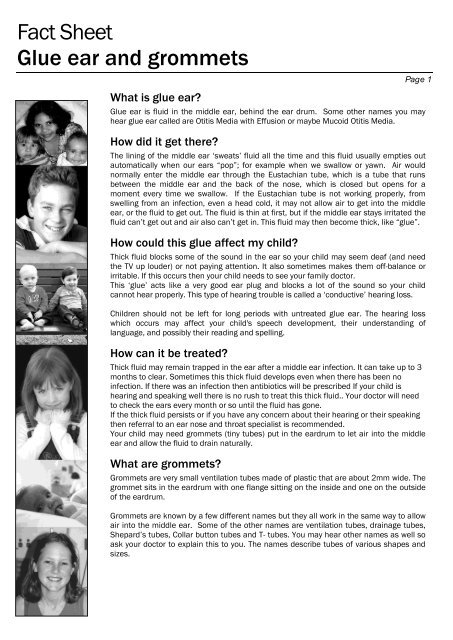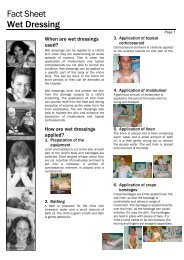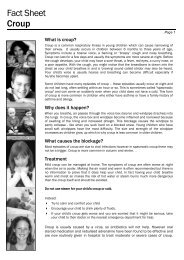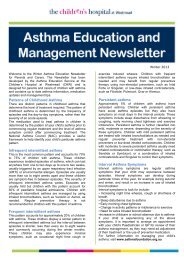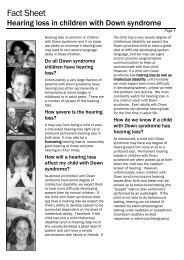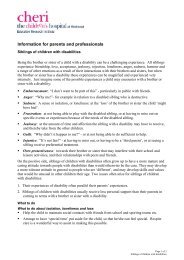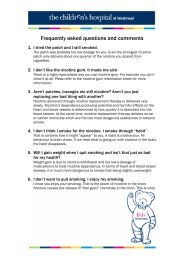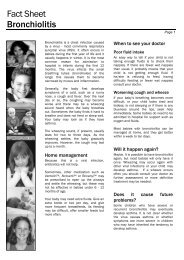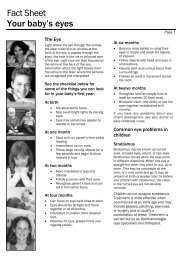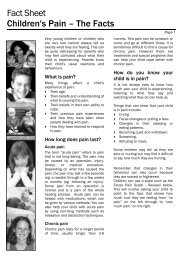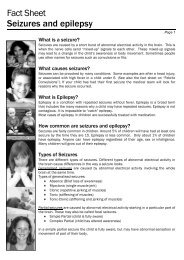Fact Sheet Glue ear And Grommets - Kids Health @ CHW
Fact Sheet Glue ear And Grommets - Kids Health @ CHW
Fact Sheet Glue ear And Grommets - Kids Health @ CHW
Create successful ePaper yourself
Turn your PDF publications into a flip-book with our unique Google optimized e-Paper software.
<strong>Fact</strong> <strong>Sheet</strong><br />
<strong>Glue</strong> <strong>ear</strong> and grommets<br />
xcvxcvxcv<br />
Page 1<br />
What is glue <strong>ear</strong>?<br />
<strong>Glue</strong> <strong>ear</strong> is fluid in the middle <strong>ear</strong>, behind the <strong>ear</strong> drum. Some other names you may<br />
h<strong>ear</strong> glue <strong>ear</strong> called are Otitis Media with Effusion or maybe Mucoid Otitis Media.<br />
How did it get there?<br />
The lining of the middle <strong>ear</strong> „sweats‟ fluid all the time and this fluid usually empties out<br />
automatically when our <strong>ear</strong>s “pop”; for example when we swallow or yawn. Air would<br />
normally enter the middle <strong>ear</strong> through the Eustachian tube, which is a tube that runs<br />
between the middle <strong>ear</strong> and the back of the nose, which is closed but opens for a<br />
moment every time we swallow. If the Eustachian tube is not working properly, from<br />
swelling from an infection, even a head cold, it may not allow air to get into the middle<br />
<strong>ear</strong>, or the fluid to get out. The fluid is thin at first, but if the middle <strong>ear</strong> stays irritated the<br />
fluid can‟t get out and air also can‟t get in. This fluid may then become thick, like “glue”.<br />
How could this glue affect my child?<br />
Thick fluid blocks some of the sound in the <strong>ear</strong> so your child may seem deaf (and need<br />
the TV up louder) or not paying attention. It also sometimes makes them off-balance or<br />
irritable. If this occurs then your child needs to see your family doctor.<br />
This „glue‟ acts like a very good <strong>ear</strong> plug and blocks a lot of the sound so your child<br />
cannot h<strong>ear</strong> properly. This type of h<strong>ear</strong>ing trouble is called a „conductive‟ h<strong>ear</strong>ing loss.<br />
Children should not be left for long periods with untreated glue <strong>ear</strong>. The h<strong>ear</strong>ing loss<br />
which occurs may affect your child's speech development, their understanding of<br />
language, and possibly their reading and spelling.<br />
How can it be treated?<br />
Thick fluid may remain trapped in the <strong>ear</strong> after a middle <strong>ear</strong> infection. It can take up to 3<br />
months to cl<strong>ear</strong>. Sometimes this thick fluid develops even when there has been no<br />
infection. If there was an infection then antibiotics will be prescribed If your child is<br />
h<strong>ear</strong>ing and speaking well there is no rush to treat this thick fluid.. Your doctor will need<br />
to check the <strong>ear</strong>s every month or so until the fluid has gone.<br />
If the thick fluid persists or if you have any concern about their h<strong>ear</strong>ing or their speaking<br />
then referral to an <strong>ear</strong> nose and throat specialist is recommended.<br />
Your child may need grommets (tiny tubes) put in the <strong>ear</strong>drum to let air into the middle<br />
<strong>ear</strong> and allow the fluid to drain naturally.<br />
What are grommets?<br />
<strong>Grommets</strong> are very small ventilation tubes made of plastic that are about 2mm wide. The<br />
grommet sits in the <strong>ear</strong>drum with one flange sitting on the inside and one on the outside<br />
of the <strong>ear</strong>drum.<br />
<strong>Grommets</strong> are known by a few different names but they all work in the same way to allow<br />
air into the middle <strong>ear</strong>. Some of the other names are ventilation tubes, drainage tubes,<br />
Shepard‟s tubes, Collar button tubes and T- tubes. You may h<strong>ear</strong> other names as well so<br />
ask your doctor to explain this to you. The names describe tubes of various shapes and<br />
sizes.
<strong>Fact</strong> <strong>Sheet</strong><br />
<strong>Glue</strong> <strong>ear</strong> and grommets<br />
xcvxcvxcv<br />
How do they work?<br />
Page 2<br />
<strong>Grommets</strong> are ventilation tubes which have a small hole in the centre which allows fresh<br />
air to enter the middle <strong>ear</strong> to keep it free of fluid.<br />
Once air can enter the middle <strong>ear</strong> it helps to improve your child‟s h<strong>ear</strong>ing by allowing the<br />
tiny bones of h<strong>ear</strong>ing to move freely again.<br />
The grommets will gradually fall out of the drum after three - eighteen months. Most<br />
children‟s h<strong>ear</strong>ing will recover fully. The fluid may come back in some children and<br />
further treatment will be needed. Some children need grommets again.<br />
Will my child need to go to hospital to have grommets<br />
inserted?<br />
Yes, your child will need to be in hospital to have the grommets inserted. It is a day only<br />
procedure so they will not need to stay overnight unless your child is having another<br />
operation at the same time.<br />
Your child will come into hospital the day they are having their operation. It is important<br />
that they don‟t have anything at all to eat or drink before the operation. The hospital will<br />
advise you what time your child needs to be „nil by mouth‟.<br />
Before the operation commences your child will be given an anaesthetic to put them into<br />
a deep sleep so that they will not feel any discomfort during the procedure.<br />
After surgery your child will be able to go home within a couple of hours, when they have<br />
woken up and had something to drink.<br />
What do I need to know about grommets when at home?<br />
Your child shouldn‟t have much pain after the operation. You should contact a doctor if<br />
they have a lot of pain after the operation, or if discharge (fluid) from the <strong>ear</strong> continues<br />
for more than 5 days.<br />
After your child has the grommets inserted you need to be careful of water getting in the<br />
<strong>ear</strong>s until the grommets have come out of the <strong>ear</strong> drum and it is fully healed.<br />
It is particularly important to keep dirty water (which contains a lot of germs) out of the<br />
<strong>ear</strong> while grommets are in.<br />
„Dirty water‟ is bath water, heated pools, spas, and rivers, lakes, dams and creeks.<br />
Showering, even with hair shampooing is OK. So it is easier to shower rather than bathe<br />
your child.<br />
If a bath is used then have it very shallow and wash hair with clean water from the hand<br />
basin or use a hand spray attachment.<br />
If none of this is possible then <strong>ear</strong>plugs should be used.<br />
There are a few different things you can use as <strong>ear</strong> plugs<br />
Custom made <strong>ear</strong> plugs can be made by h<strong>ear</strong>ing aid suppliers<br />
Soft plastic plugs can be bought at some shops<br />
Silicone <strong>ear</strong> putty<br />
Blu-tack<br />
Cotton wool sm<strong>ear</strong>ed with Vaseline
<strong>Fact</strong> <strong>Sheet</strong><br />
<strong>Glue</strong> <strong>ear</strong> and grommets<br />
xcvxcvxcv<br />
This fact sheet is for education purposes only.<br />
Please consult with your doctor or other health professional<br />
to make sure this information is right for your child. This document was reviewed on 25 th November 2011<br />
The next date of review for this document is 25 th<br />
November 2013<br />
www.chw.edu.au www.sch.edu.au www.kaleidoscope.org.au<br />
Page 3<br />
It is important that if you use putty or blu-tack that you use a piece as big as your child‟s<br />
outer <strong>ear</strong> and not a piece small enough to get stuck in the <strong>ear</strong> canal.<br />
Can we still go swimming?<br />
Yes, but not for the first week after the operation.<br />
Swimming at an ocean beach needs no special care but in other places <strong>ear</strong> plugs should<br />
be used and these need to be supported with a swimming cap or an <strong>ear</strong> wrap-type<br />
headband.<br />
What if water gets in my child’s <strong>ear</strong>s while the grommets<br />
are there?<br />
Chances are nothing will happen. But an <strong>ear</strong> infection can develop. This will be seen as<br />
discharge (fluid) coming from the <strong>ear</strong> needing treatment with <strong>ear</strong> drops. Your child should<br />
not swim until the infection is gone.<br />
Swimming with an <strong>ear</strong> infection can spread the infection to other people.<br />
Do I need to know anything else?<br />
Because h<strong>ear</strong>ing loss occurs in glue <strong>ear</strong>, it is very important that your child has a h<strong>ear</strong>ing<br />
test after the glue <strong>ear</strong> is better; that is soon after the grommets have been put in, or if<br />
the glue has gone away itself.<br />
H<strong>ear</strong>ing tests for children are available in some hospitals, community health centres, in<br />
some <strong>ear</strong>, nose and throat specialists' offices or at Australian H<strong>ear</strong>ing Services. If the<br />
h<strong>ear</strong>ing is not back to normal, further investigation is needed.<br />
If your child has grommets they will need to have their <strong>ear</strong>s checked regularly to see if<br />
the grommets are still in the <strong>ear</strong> drum and still working.<br />
Remember<br />
<strong>Glue</strong> <strong>ear</strong> should not be left untreated for long periods of time.<br />
Your child should have a h<strong>ear</strong>ing test after they have their grommets.<br />
Your child should use water precautions when in the bath or swimming in dirty<br />
water until the grommets are out.<br />
© The Children’s Hospital at Westmead, Sydney Children’s Hospital, Randwick & Kaleidoscope * Hunter Children’s <strong>Health</strong> Network – 2005-2011


